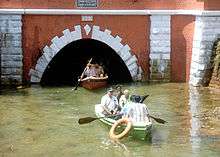Varkala Tunnel
Varkala Tunnel System, situated in municipality of Varkala of Trivandrum, Kerala, India, also known as the Varkala Canal or Varkala Thurapp in local dialect. It is one of the historic sites and architectural marvel of the region. This site was constructed by the Travancore Kingdom to establish a continuous inland waterway across Thiruvithamkoor as TS Canal, which was meant to serve as a trade route. The construction of the two long tunnels was started around the mid-1860s and first one opened in 1867 and took around 14 years to complete two tunnels of totally 1 km.[1]

 Former Chief minister VS Achudhananthan visiting Varkala Tunnel in 2006 | |
| Overview | |
|---|---|
| Location | Varkala, Trivandrum, Kerala |
| Coordinates | |
| Status | Closed 2007 |
| Route | Trivandrum-Kollam |
| Start | 8.7365°N 76.730°E |
| End | 8.7167°N 76.721°E |
| Operation | |
| Work begun | 1860 |
| Constructed | Kingdom of Travancore |
| Opened | 1867 |
| Owner | Government of Kerala |
| Operator | Kerala Inland Waterways and Infrastructure limited |
| Traffic | National Waterway 3 |
| Toll | No |
| Technical | |
| Length | 1,069.848 m (1.069848 km) |
| No. of lanes | 2 |
| Operating speed | 25 km/h (16 mph) |
| Tunnel clearance | 10 metres (33 ft) |
| Width | 13m (planning to increase to 43m) |
 |
With a length of 1,069.848 metres (1.069848 km), the two tunnel played a vital role in transferring ferry goods and people from capital city Trivandrum to Kollam during the pre-independence era. The tunnel is located under the main cliff of the region and represents the architectural excellence of the workers and engineers of that era.[2]
.jpg)
Built under the supervision of T. Madhava Rao, the Dewan of Travancore Kingdom, the tunnel also make up for the Varkala reach of Thiruvananthapuram–Shoranur canal, which passes through this delicate structure.[3][4]
Features
The tunnel is built in an area that is famous for Cenozoic sedimentary formation cliffs are a unique geological feature on the otherwise flat Kerala coast, and are known among geologists as Varkala Formation. The tunnels are carved through Laterite rocks.
There are two tunnels in the system namely,
- Sivagiri Passage 722 m long and,
- Chilakkoor Passage 350 m long.
The tunnel system connects the Anchuthengu Kayal with Edava- Nadayara Kayal.
Present Status
Despite of immense tourism potential the passages are remaining as unused. It is silted and maintenance works are all in limbo. In 2006 period there was a renewed interest to revive the tunnels by then Chief minister of Kerala, Shri. V. S. Achuthanandan he had even undertaken a boat ride in the canal to make a first-hand assessment. There after it was in limbo until 2014 -16 period, when few discussions started again and died down as usual. In 2016, the state government had sought the help of Metroman E. Sreedharan to revive the tunnel.[5]
In 2017 there were discussions to construct new waterway bypass skipping existing tunnels due to lack of width and draft as per National Waterways standards.[6]
As of 2020, in Chilakkoor passage, dredging work and sledge removal are progressing. Works on Sivagiri passage is also expected to start soon. The passages are planned to be used for tourist activities.
Also Government of India has turned down Kerala's demand to extend the existing National Waterway 3 route to Kovalam from Kollam through Varkala.
See also
References
- Wright, Colin. "Varkala Tunnel". Bl.uk. Retrieved 14 September 2018.
- Wright, Colin. "Varkala Tunnel". www.bl.uk. Retrieved 24 October 2018.
- "Varkala Tunnel, Thiruvananthapuram, Kerala, India - Kerala Tourism". www.keralatourism.org. Retrieved 24 October 2018.
- "Archived copy". Archived from the original on 14 September 2018. Retrieved 14 September 2018.CS1 maint: archived copy as title (link)
- Radhakrishnan, S. Anil (16 October 2016). "Sreedharan's help sought to revive tunnels". The Hindu. ISSN 0971-751X. Retrieved 15 April 2020.
- "Kerala government to extend West Coast Canal to Kovalam, Varkala tunnels may lose its glory". The New Indian Express. Retrieved 15 April 2020.